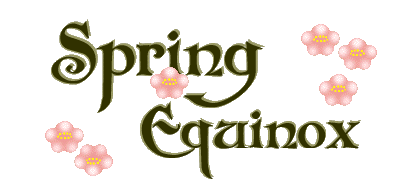 Springtime officially arrives
on or around March 21 in the northern hemisphere and
September 23 in the southern hemisphere, when the sun is
directly over the equator and the hours of daylight and dark
are equal. "Equinox" means "equal night." The earth warms,
and plant and animal life begin to grow and thrive.
Springtime officially arrives
on or around March 21 in the northern hemisphere and
September 23 in the southern hemisphere, when the sun is
directly over the equator and the hours of daylight and dark
are equal. "Equinox" means "equal night." The earth warms,
and plant and animal life begin to grow and thrive.
 The release of winter from
the land varies with latitude, of course, so traditional
festivities to welcome the growing season may be celebrated
on holidays all through the springtime season. The equinox
itself typically is welcomed as a time of spiritual
importance even where spring growth has not yet begun.
The release of winter from
the land varies with latitude, of course, so traditional
festivities to welcome the growing season may be celebrated
on holidays all through the springtime season. The equinox
itself typically is welcomed as a time of spiritual
importance even where spring growth has not yet begun.
Easter and Passover are celebrated on dates related to
the full moon following the vernal, or spring, equinox. Many
cultures consider the spring equinox, or the nearest full
moon, to be the first day of a new year. To the ancient
Greeks the first day of Spring was the time when Persephone,
held in the underworld for six months, was allowed to return
to her mother Demeter, goddess of agriculture. The mother's
joy allowed a new growing season to begin.

In Japan, Shunbun No Hi or Spring Higan,
the vernal equinox, is a national holiday and a week-long
festival when families hold religious rites in memory of the
dead. Higan, or politely O-Higan, means "the other shore" or
"the other side of the river crossed by the dead." On the
21st, people visit cemeteries to offer respects to their
ancestors on the other side.
The festival dates back to the 8th century or earlier,
and is based upon a Buddhist perception that the equinox is
a day of perfect union favoring neither light nor dark,
indicating the oneness of good and evil, the reality of the
Middle Way. At the equinox Buddha appears on earth for a
time to gather in lost souls and lead them to Nirvana.
Higan is a festive, not sad, social occasion, with family
visits and specially prepared traditional foods.

